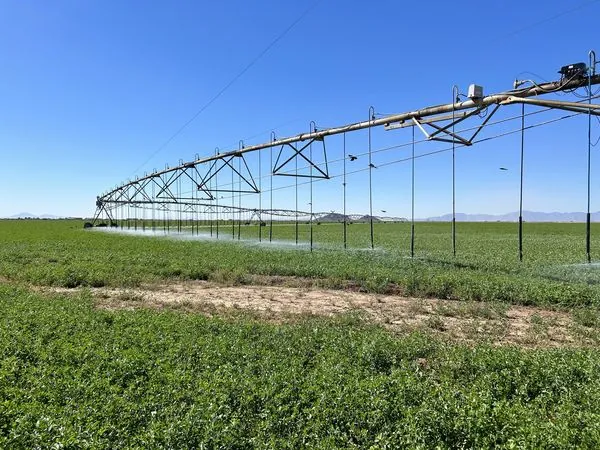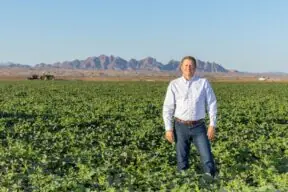Farm Facts That Feed You
Arizona Water Use Facts

Back
Arizona Water Use Facts
- Agriculture uses 72% of Arizona’s water, according to the Arizona Department of Water Resources.
- Most countries where agriculture is a significant part of the economy use between 75% and 90% of their total water resources for farming. If a country’s agricultural water consumption falls outside this range, particularly below 70%, it might indicate that the nation’s agricultural output is insufficient to sustain its population.
- Historically an ongoing effort, farmers and ranchers continue improving their water use, reducing the amount used by as much as 50% in some cases. Together farmers and ranchers are dedicated to preserving this precious resource to keep everyone fed and clothed.
- The other two water use segments are residential and industrial.
- As agriculture converts to residential or industrial water use percentages will change.
- Ultimately you need Arizona agriculture, and Arizona agriculture needs water to meet your daily nutritional needs.
- In 2022, legislation passed at the Arizona Legislature that committed $1.2 billion for water augmentation and conservation, including $250 million specifically for rural water supply development.
- Arizona leads the nation with rigorous water conservation efforts, and because of the 1980 Groundwater Management Act, Arizona has the legal and physical infrastructure that maintains a 100-year assured water supply to meet the current and future needs of residents and industry.
- Arizona is currently below 1957 water usage levels due to increased conservation methods and the decrease in water used for agriculture, according to the Arizona Department of Water Resources.
Arizona has five times (5x) more water stored than we use and has never mandated municipal or residential restrictions on uses throughout our state’s history. - On Monday, Aug. 16, 2021, U.S. officials declared the first-ever water shortage from the Colorado River that caused Arizona to take an 18% cut starting in 2022. This does not impact municipal or residential uses.
- Arizona has the junior water position along the Colorado River and that’s been the case since 1968 when the Central Arizona Project was authorized. Because of our long-standing position, we have been prepared for decades and implemented long-term planning and solutions. These planning and solution-development strategies continue to this day.
- California has limited groundwater management infrastructure in place compared to Arizona. In fact, California sends more water back to the Pacific Ocean each year than the City of Phoenix uses in total.
- 93% of the water that enters the Greater Phoenix waste stream can be reclaimed and treated for potable use and this is a huge differentiator for Arizona. Arizona is a national leader when it comes to the reuse of water.
Specific Agricultural-focused Water Facts
- Arizona has 13.2 million acre-feet of water stored in reservoirs as well as underground, with 7.1 million acre-feet of that total stored in Greater Phoenix.
- Because of the infrastructure in place, we can pull and replace water as needed, making our water supply more resilient during times of drought.
- Arizona’s diverse water portfolio encourages efficient use of water resources, allows us to subsist even in drought conditions and provides more options when planning our state’s future economic growth.
- While Arizona’s agricultural water use has continued to decline through conservation practices and less farming, Arizona has a multi-faceted portfolio of water supplies with the most advanced program for managing groundwater in the country.
- The state’s vast aquifers (underground reservoirs) allow us to access water during times of drought, and we’ve been prepared for decades for shortage declarations.
- It’s unfounded to group Arizona in with other Western and Mountain West states when it comes to the shortage along the Colorado River because our state is far less reliant than competitor markets due to its multi-faceted portfolio of surface and groundwater options.
- Only 36% of the Arizona water supply is provided by the Colorado River; Nevada and California have a much higher reliance.
- We’re proud of Arizona agriculture’s water use as it results in food and fiber for everyone.
Arizona enforces mandatory water conservation requirements for most water users. In Agriculture …
- No new agricultural acreage may enter production in active management areas.
- Each farm (Irrigation Grandfathered Right) is assigned a maximum annual groundwater allotment, based on assumed irrigation efficiencies of 65% to 80%.
- The best management practices program ensures that water is being used as efficiently as possible on the most productive land available.
- Farms regularly improve and institute water-saving technology including new seed varieties, improved water distribution methods and precision land leveling.
- Arizona’s population growth means more demand for municipal water. But Arizona’s water use is essentially the same as it was more than half a century ago due to investments in water conservation and infrastructure.
- All of this means you live in a state fully protecting its water supply!
When you waste your food, you waste water.
- Every bite of food you take contains water.
- Calculating the water it took to grow the food on your plate, you’re eating nearly 2,000 gallons of water a day.
- Example foods (2,000-gallon daily food intake not reflected) – Gallons of Water (During Production)
- Two eggs – 126 gallons
- Taco Salad – 806 gallons
- Quarter cup almonds – 180 gallons
Pinal County Does Wonders with Water
- Pinal County is home to more than 900 farms.
- The water lets farmers grow cotton, alfalfa, wheat, melons, and more!
Farms are also major employers in Pinal County. - They also support many of the county’s other small businesses.
- It’s all possible because of water!
Maricopa County’s Gila Bend Basin
- Approximately 20% of Arizona’s Milk is produced in the Gila Bend Basin
- The Gila Bend Basin has a large aquifer with an incredible ability to recharge when the Gila River flows.
- The Gila Bend Basin has two of the first RNG (Renewable Natural Gas) facilities for the state, producing enough natural gas for approximately 6 Megawatts of Electricity
Many of Arizona’s biggest urban areas were settled because of irrigated farming.
- Phoenix began when a farmer began growing wheat, barley, and corn with Salt River water.
- Tempe arose after the building of the Kirkland-McKinney and San Francisco irrigation ditches.
- Mesa was settled by expert agriculturalists and irrigators.
- Grand Avenue was constructed to provide transportation for agricultural products…
- …and that’s why Glendale exists!
- Urban Arizona exists thanks to agricultural water users.
Sources: Our Arizona farmers and ranchers, Arizona Department of Water Resources, ASWR, The University of Arizona, U of A’s Water Resources
Our Videos
View all VideosOur Latest Posts

Crop Protection from Insect Pests: How Farmers Win the War on Bugs
According to a report by UC Agriculture and Natural Resources, farmers lose 10% to 40% of their crops to pests and plant diseases. On a…

Nutrition for Cycling: How Proper Nutrition Fuels Cyclists from the First Mile to the Finish Line
Cycling is a sport built on rhythm, the turning of your pedals, the cadence of your breath, and the flow of your energy as the…
Featured Recipes

Provided by: Garry Domingue, Rosie on the House Producer and Foodie












